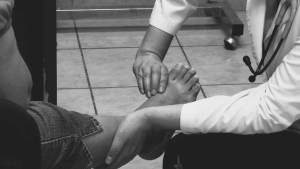Martin Klinke outlines Ms D’s symptoms that led her to seek LFAC out, the treatment doctor and patient decided on, and shares her lovely feedback regarding her recovery after ankle surgery.
Ms D, a charming active 65 year old lady came to see me in March 2023 because of increasing pain in both ankles, the left being worse than the right. She could not recall an initial injury but over the last five years her ankles affected her lifestyle increasingly. She became aware of some swelling and a slight deformity of the hindfeet which reduced her walking distance considerably.
She used to be very active, she enjoyed walking, did ice skating and dancing. She was seen in 2018 by someone and was told that she would benefit from some treatment when her symptoms are worse. When she came to see me Ms D was not able to enjoy her activities any longer and was becoming more and more immobile.


On examination Ms D presented with swollen ankle joints which were in a moderate varus position which means her ankles/heels tilted inwards in relation to her lower limbs. Ms D had considerably reduced movement of the ankles upwards whereas she had sufficient movement of the ankle joints downwards. Due to the deformity and stiffness, she was limping. As expected, she was tender on palpation across the front but also on the inside and the outside of the ankle joints whereas the swelling was most pronounced on the outside of her ankle joints. The neighbouring hindfoot joints were all flexible und not tender on examination.
To get further information about her ankle and hindfoot joints we arranged weightbearing X rays which did confirm pronounced osteoarthritis with a varus deformity of both ankle joints, the left again a bit more pronounced than the right. The subtalar and the transverse tarsal joints all looked good.
Ms D was well informed about the various treatment options for arthritic ankle joints and we discussed those again. I explained that an ankle joint fusion which means fusing the tibia and the talus together with the help of metalwork is certainly a good operation which should take away the pain and the outcome is very predictable. She would not have an obvious limp and she certainly would have a better position than her ankles were in now.
As Ms D had an overall decent range of movement and only lacked some dorsiflexion of her ankle, most likely due to bone that had grown at the front of the ankle (called osteophytes), an ankle joint replacement was also discussed. An ankle joint replacement is a resurfacing of the talus and the tibia which are the two bones which form the ankle and I showed her some images on the computer of how and ankle joint replacement looks like.
The benefit of an ankle joint replacement is that one can preserve, and even improve, range of movement of the joint and that would reduce the stress on the other joints. In order to improve dorsiflexion one would potentially also have to do a lengthening procedure to the Achilles tendon or the calf muscle and in case we could not get the heel in a good position we would potentially also have to do a calcaneal osteotomy.


I also explained the recovery after ankle surgery, which involves different weightbearing timelines: two weeks non-weightbearing followed by four weeks partial weightbearing for a replacement, and six plus six weeks respectively for a fusion.
Ms D was very keen to consider an ankle joint replacement which I also thought was a good option for her. We therefore arranged a standing CT scan to get further information about her bony alignment and those images were sent off to the company that then produces cutting devices that allows the surgeon to prepare the ankle joint as accurate as possible for the implantation of the joint replacement.
Ms D then had her left ankle joint replaced after the summer 2023. Fortunately, we did not need to lengthen the Achilles tendon or the calf muscle to improve her range of movement and we did not have to cut the heel bone as the resection guides allowed to insert the components so well that her bony alignment was anatomically restored.


As pre-operatively discussed Ms D was in a half plaster non weight bearing for the first two weeks. As her wound looked vey nice, she was then allowed to start partial weight bearing in a removable boot that has a hinge to allow some up and down movement of the ankle joint in order to prevent any stiffness in the ankle joint – a key step in her recovery after ankle surgery.
Within a few weeks she felt very comfortable in the boot and was fully weight bearing 6 weeks after the operation. She was therefore allowed to start walking out of the boot indoors and in safe environment and a few weeks later also outdoors. She was always cautious and did not overdo it and within a few months she was walking around with very little swelling and no problems except for being limited by her painful right ankle.
We wanted Ms D to be absolutely fine and safe before we went ahead to replace the right ankle as post operatively, she would have to be absolutely fit and stable and able to put all her weight through her left ankle. In May 2024 Ms D went ahead and had the right ankle joint replaced using again custom-made cutting devices to get a perfect fit of the ankle joint implants.
Her second recovery after the ankle surgery was again very uneventful and having had the previous experience she felt that she was able to achieve good range of movement of the ankle joint and full support even quicker than the first time. Within three months Ms D was up and about walking fairly normal and increasing her walking distance continuously.


Ms D is extremely happy with the outcome of both of her operations as she is now back to most activities including walking up to a mile without having any ongoing pain. We were able to not only preserve but increase the flexibility of her ankle joints which means that there is no additional stress on the neighbouring joints – a great example of successful recovery after ankle surgery.
Knowing that ankle joint replacements nowadays have a much better survivorship and having experience in ankle joint replacements for over 20 years myself as a surgeon I know who is a good candidate for an ankle joint replacement and who is less likely to benefit from the newest generation of ankle joint replacements.
The decision is made on an individual basis taking into account multiple factors including flexibility and alignment of the joint, history of previous trauma to the ankle joint, patient’s level of activities, patient’s expectations as well as the age of the patient.
Fortunately, more and more patients nowadays can benefit from the much-improved surgical techniques and the considerably better implants to have their ankle joint replaced which is reflected in the increasing number of ankle joint replacements performed in the UK. As well as reflected in their smoother and a smoother recovery after ankle surgery.
This is patients e mail after 3 months. Morning Caroline I was just thinking it’s now been three months since my second ankle was done. Please can you tell Mr Klinke that I have come on leaps and bounds. I walk a lot now and have no trouble at all really . I am also doing an exercise class online each day which equates to walking a mile. I even tried a line dancing class recently. So all in all the recovery has been amazing and no one can believe I’m out walking with my son and his dog and friends for country walks. All with an odd bench rest when needed. It still swells a little by the end of the day but always goes down overnight. I manage either with no pain relief or two ibuprofen in the morning if I have a busy day planned. Even coming down stairs is easier now. All in all I couldn’t have hoped for a better outcome. Ms. D
Ms. D
Q – How long until I can walk after ankle surgery?
Recovery after ankle surgery requires careful staged rehabilitation. In Ms D’s case, we followed a structured timeline.
- 2 weeks in a half plaster cast, non‑weight-bearing
- 4 weeks partial-weight-bearing in a hinged boot
- 6 weeks full weight-bearing indoors and outdoors
- Within 3 months: walking well, resumed daily activities.
Q – After my recovery from ankle surgery, when can I return to work?
Most patients wait 6 weeks before driving; many return to desk-type jobs around this time, though manual roles may need longer.
Considering ankle surgery or concerned about your recovery? Contact our expert team to discuss your options and learn more about what to expect during recovery after ankle surgery.


Martin Klinke
Mr Martin Klinke is an orthopaedic surgeon, with qualifications in orthopaedics and sports medicine. He has been with LFAC since 2004.


